One of the lowest points in X-Men history would have to be the early seventies, as their comic book had been canceled with #66 in March 1970. However, Marvel officials soon realized that there was still some interest in the mutant teenagers, which is why later that year they decided to continue the series, the book now containing reprints of older stories. In 1972, editor Roy Thomas had the idea for a new X-Men book in the style of some “mutant blackhawks.“ He met up with writer Mike Friedrich and artist Dave Cockrum to discuss his idea, which involved the X-Men to have a more international membership, as Marvel was looking for foreign markets. For some reason, though, there was a pause in development, and the idea was only picked up again in 1975. By then, Friedrich wasn’t involved anymore, Len Wein now being the writer for the project. However, as he soon became Marvel’s editor-in-chief, Wein could only write the first issue and plot the new X-Men’s second adventure, before he handed over the writing to Chris Claremont. The rest is history. What started out as an attempt to breathe some new life in a failed idea became the biggest franchise in comic industry. This article will take a look at the creative process of Dave Cockrum when it came to designing the all-new, all-different X-Men.
The first new X-Man that was introduced in Giant-Size X-Men #1 was Nightcrawler, who is also the one character that was conceived long before there was the idea to relaunch the X-Men. Before he became a professional artist, Dave Cockrum was in the Navy, stationed in Guam together with his first wife. One night, “there was a terrible storm going on overhead, we had no lights, it was noisy and loud and raining like hell with thunder and lightning. To keep ourselves occupied and keeping ourselves from being scared to death, we sat around making up characters. We made up this duo, a guy I called the Intruder (a cross between the Punisher and Batman, with a chrome skull and black jumpsuit) and his demon sidekick, Nightcrawler. The original concept was a lot different in that Nightcrawler would howl at the moon, run up the sides of buildings and do all kinds of weird shit. He really was a demon who had screwed up on a mission from hell and, rather than go back and face punishment, he hung around up here with this do-gooder.“
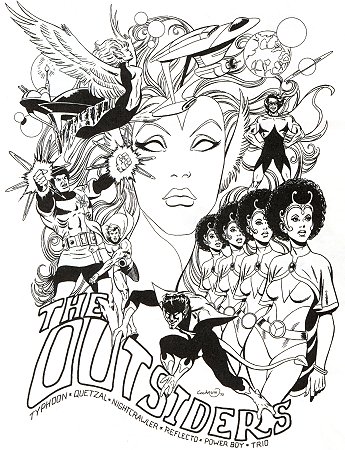
When Cockrum was working for DC Comics, he suggested Nightcrawler as a potential member for the Legion of Super-Heroes, and later for a Legion offshoot called "The Outsiders," but the editor considered the character too funny looking. DC’s loss was Marvel’s gain, as Dave Cockrum kept all of his designs for potential later use. When he met up with Len Wein to discuss the new X-Men, he also showed him the Outsiders, and Nightcrawler ended up becoming one of Marvel’s merry mutants. His backstory and origin was completely changed though. Cockrum’s second wife, Paty, also had some influence on Nightcrawler a bit later on, as Claremont liked her suggestion that the blue skin was actually short fur that had the feel of velvet, which he then incorporated into the stories.
According to both Wein and Cockrum, Colossus was the easiest of the new X-Men to create. The international cast idea in mind, Len Wein aimed for the “Russian strong-man“ concept and, among the many designs that Cockrum had previously done, they found Colossus, 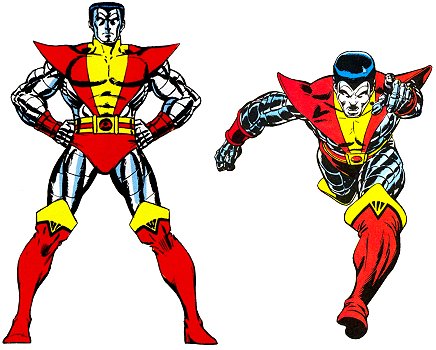 who had the power to transform into steel. It was a perfect match. While Len Wein came up with the name Peter Rasputin (after the Russian leader, Peter the Great, and the mad monk, Rasputin), Cockrum slightly altered the visuals according to the Russian background, by making Colossus blocky and giving him a buzz cut. Very early plans had Colossus eventually become the new X-Men’s leader, explaining why he seems to be in charge of the team on the cover of Giant Size X-Men #1, but Chris Claremont took the character down a different road, turning him into a troubled artist with a severe culture shock.
who had the power to transform into steel. It was a perfect match. While Len Wein came up with the name Peter Rasputin (after the Russian leader, Peter the Great, and the mad monk, Rasputin), Cockrum slightly altered the visuals according to the Russian background, by making Colossus blocky and giving him a buzz cut. Very early plans had Colossus eventually become the new X-Men’s leader, explaining why he seems to be in charge of the team on the cover of Giant Size X-Men #1, but Chris Claremont took the character down a different road, turning him into a troubled artist with a severe culture shock.
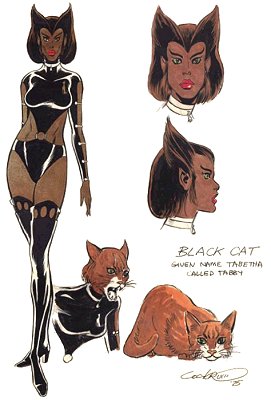
Storm is perhaps the best example of how a character’s look develops from creative conception to creative result. After first learning of the new X-Men series in 1972, Dave Cockrum designed a black, female member called the Black Cat, who wore a collar with a bell on it. Her power was that she could turn into any cat, from a house-cat to a panther, and she could also half-transform into a humanoid cat. However, as in the meantime several other female feline characters had been introduced - for example Tigra, the were-woman, in 1974 - the Black Cat didn’t make the cut. The rest of the new X-Men roster already having been picked, Wein and Cockrum still needed a female member and, thinking that the costume design for the Black Cat actually fit the X-look, they just needed some different super-power for her.
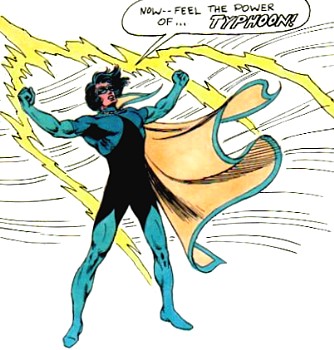
At that point, they recalled Typhoon, another character who had originally been designed for the “Outsiders.“ Visually not being the best concept, his power to manipulate the weather was quite interesting, so it was decided to merge the two characters. As the Black Cat’s hair-do and facial features were connected to her intended cat powers, they too had to be changed. Once more, Cockrum found something in his sketches for the “Outsiders” he could make use of.
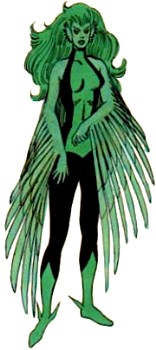
One member of the team, Quetzal, was supposed to be green bird-woman of unknown origin. The alluring female was rather tall, had hollow bones and feathered wings which grew out of her arms. Adding Quetzal’s long flowing hair and beautiful facial features to the design for the X-woman, Dave Cockrum decided to keep the Black Cat’s catlike eyes, as they sort of matched the shape of Quetzal’s hairline and looked quite good together.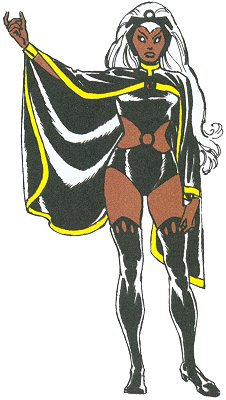
Still not complete, Storm was also given a tie-to-the-wrists cape that Cockrum had tried out with some other designs before. Apparently, he first came up with the dark cloak with yellow trim, held together by a gemstone, when he conceived Trio, yet another creation for the never realized “Outsiders” idea. Next, the cape was used for an unsuccessful re-design of Marvel Girl (see below), this time it already sporting the trademark W-shaped trimline in the back. When it was finally given to Storm, the cape had grown in size and was more like a poncho, so that it could also serve as “wings” on which she could glide more easily while manipulating the winds.
The white hair color was a last-minute inspiration of Dave Cockrum and he managed to convince Len Wein of this idea, who was concerned that the character might end up looking like “somebody’s grandmother.”
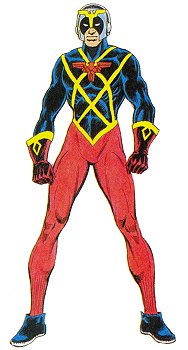
While Thunderbird was destined to die right from the start, to show the readers that superheroes were vulnerable too and anything could happen in this title, the creative team still wanted to make sure that the character would have the right look. When Dave Cockrum handed in his original costume design for Thunderbird, everybody agreed that he looked more like an Air Force pilot rather than a Native American warrior. Ironically, much later produced flashback stories would indeed reveal the character to have a military background. Back in 1975, though, Dave Cockrum found a way to combine the functionality of the traditional dress found in Native American culture with the colorfulness associated with a comic book super hero. Uncanny X-Men #193, the 100th issue of the all-new, all-different X-Men, introduced a younger brother of Thunderbird, who wore a simulacrum of this costume for quite some time.
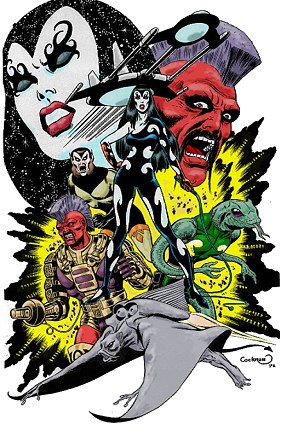 Everybody knows that Dave Cockrum had no hand in the creation of Wolverine,... well, that is the Wolverine who ended up being used for the X-Men. In fact, Cockrum had also designed a rival team for the aforementioned “Outsiders”, who would have been called either “Devastators” or the “Strangers” and were also among the many images that Cockrum had shown to Roy Thomas. “One of them would up later being used as Tyr in the Legion of Super-Heroes, the guy with the gun on his hand. But anyhow, two of them were brother and sister. She was a vampire who, by one method or another, was going to try to keep it under control, possibly just bite people once and leave them alone, and not kill them off. He was a vulpine type: animalistic, bestial, feral, whom I called Wolverine. [...] In the interim, somewhere along the line, Roy suggested to Len, 'How about a Canadian mutant called Wolverine?' I assumed Roy just forgot that I showed him my Wolverine. I was kind of miffed about the whole thing, but it seemed kind of pointless to carry it on. I never did like Wolverine for a long time."
Everybody knows that Dave Cockrum had no hand in the creation of Wolverine,... well, that is the Wolverine who ended up being used for the X-Men. In fact, Cockrum had also designed a rival team for the aforementioned “Outsiders”, who would have been called either “Devastators” or the “Strangers” and were also among the many images that Cockrum had shown to Roy Thomas. “One of them would up later being used as Tyr in the Legion of Super-Heroes, the guy with the gun on his hand. But anyhow, two of them were brother and sister. She was a vampire who, by one method or another, was going to try to keep it under control, possibly just bite people once and leave them alone, and not kill them off. He was a vulpine type: animalistic, bestial, feral, whom I called Wolverine. [...] In the interim, somewhere along the line, Roy suggested to Len, 'How about a Canadian mutant called Wolverine?' I assumed Roy just forgot that I showed him my Wolverine. I was kind of miffed about the whole thing, but it seemed kind of pointless to carry it on. I never did like Wolverine for a long time."
Despite his dislike for the character, Wolverine serves as a good example for another treat of a good artist like Dave Cockrum – to know quality when he sees it. Gil Kane, the cover artist of 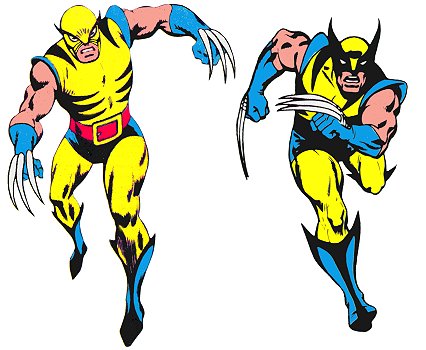 Giant Size X-Men #1, accidentally drew Wolverine's mask wrong, instead of the animalistic look of John Romita Sr.‘s original design, it had much larger head-wings. Believing it to be similar to Batman's mask, Dave Cockrum happened to like Kane's alteration and decided to incorporate it into his own artwork for the actual story. Rumor has it that the difference was only noticed after the artwork for the issue was already finished, and that Dave Cockrum had to ink bigger ears on every drawing of Logan.
Giant Size X-Men #1, accidentally drew Wolverine's mask wrong, instead of the animalistic look of John Romita Sr.‘s original design, it had much larger head-wings. Believing it to be similar to Batman's mask, Dave Cockrum happened to like Kane's alteration and decided to incorporate it into his own artwork for the actual story. Rumor has it that the difference was only noticed after the artwork for the issue was already finished, and that Dave Cockrum had to ink bigger ears on every drawing of Logan.
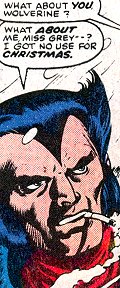
Cockrum was also the first artist to portray Wolverine without his mask. Originally, he wanted Wolverine to be a young adult, but Cockrum changed his mind after seeing a character sketch of John Romita, revealing the mask-less Wolverine to be a hairy 40-year-old. The distinctive hairstyle with the “horns“ on the side, echoing the shape of the mask, was entirely Cockrum’s idea and became a trademark of the character. It was not only Logan’s age that was overhauled, as co-creator Len Wein’s intended origin involved the character being a mutated wolverine, a wolverine cub that was evolved to humanoid form by the High Evolutionary. This idea was nixed when Spider-Woman was later revealed as an evolved spider, disgusting Marvel Publisher Stan Lee so much that he insisted that her origin was changed. Lee's strong reaction and subsequent demand for a retcon convinced Cockrum and Claremont that they could never get away with introducing Logan as a mutated wolverine.
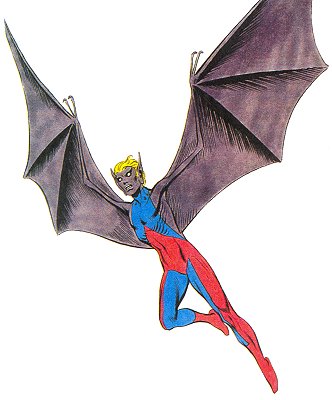
Another candidate for the new X-Men was Vampyre. Dave Cockrum thought “it would be interesting to include a bat-winged character. I never addressed the question of whether he was actually a vampire or not, but I'd imagine that either he wasn't or that Prof. X had come up with some sort of serum which allowed him to control blood-urges. But the others involved in restarting the new X-Men - Roy Thomas, Len Wein, Chris Claremont and a couple of others of editorial staff who were kibitzing - felt that Vampyre and Nightcrawler were visually similar types and if it came to a crunch, personally I preferred Nightcrawler. Thus are characters left 'on the cutting room floor'.“
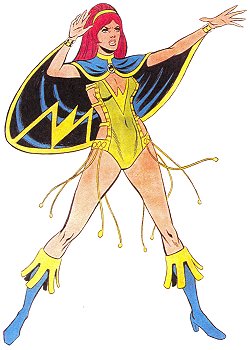
Considering Marvel Girl’s mini-skirt costume somewhat outdated, Dave Cockrum attempted to design a new look for Jean Grey that resembled that of a go-go girl, clearly showing the influence of the late-sixties and early seventies. No one involved, including Cockrum, was happy with the idea and, as Marvel Girl was scheduled to leave the X-Men anyway, no other costume re-design was tried out. However, things changed when Chris Claremont came aboard. Jean Grey was a favorite character of his and, even though it was too late to change the scene in which she departed, along with the other veteran X-Men, Claremont brought her back as soon as possible, and in a big way.
It took Dave Cockrum numerous attempts to design the Phoenix costume. Below you can see two of these sketches. Whereas the one the left had more of the “otherwordly” look that they were aiming for, the final design was the far stronger image in its simplicity. Interestingly, Cockrum actually wanted the Phoenix costume to be white instead of green, but in the seventies the paper quality and printing process didn’t allow that. The text or images on the other side of the page would have shined through, always making the costume look dirty. On the right, there is a pin-up that shows Phoenix in the way Dave Cockrum had envisioned her. Years later, however, the white Phoenix costume ended up being used, namely for a few scenes when the character met Death in the afterlife or when she entered the so-called “white hot room.“ These scenes can be found in Classic X-Men #43, X-Men Forever #3 and X-Men: Phoenix - Endsong #5.
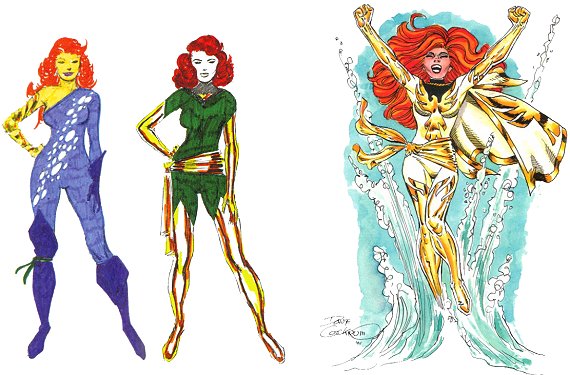
Just like Dave Cockrum had used some of his earlier ideas when it came to creating the X-Men, he kept the rejected X-Men designs for later use. Eventually in what turned out to be the last issue of his first run on the X-Men, X-Men (1st series) #107, that introduced the Shi’Ar Imperial Guard, he was able to give  some of his other creations a chance to shine in the spotlight. Most members of the Imperial Guard were an homage to DC’s Legion of Super-Heroes. The psi-talented Oracle got to wear a redesigned version of the rejected Phoenix outfit, as is clearly apparently by the tone-in-tone color scheme, the asymmetrical boots and the bubble logo moving from the right hip up to the left shoulder. Ironically, the story mirrored the situation of the two Wolverine designs, as it had Fang, a dead ringer for Cockrum’s Wolverine, face Logan in a direct one-on-one battle that occurred off panel, behind the scenes. Fang was defeated and, while in real life he had lost his codename to the Canadian mutant, in the issue he was forced to hand over his costume as well, as Logan needed something to wear, his own costume having been burned away by another Guard member.
some of his other creations a chance to shine in the spotlight. Most members of the Imperial Guard were an homage to DC’s Legion of Super-Heroes. The psi-talented Oracle got to wear a redesigned version of the rejected Phoenix outfit, as is clearly apparently by the tone-in-tone color scheme, the asymmetrical boots and the bubble logo moving from the right hip up to the left shoulder. Ironically, the story mirrored the situation of the two Wolverine designs, as it had Fang, a dead ringer for Cockrum’s Wolverine, face Logan in a direct one-on-one battle that occurred off panel, behind the scenes. Fang was defeated and, while in real life he had lost his codename to the Canadian mutant, in the issue he was forced to hand over his costume as well, as Logan needed something to wear, his own costume having been burned away by another Guard member.
At the age of 63, Dave Cockrum passed away on November 26th, 2006, after years of struggling with diabetes. Even though he never received any big royalties for his work, he touched the hearts of fans and fellow creators all over the world. Without him, the X-Men wouldn’t be where they are today. Thank you, Dave, you will always be remembered...
The images, quotes and information used for this article were found in the following issues and online resources:
- All-New, All-Different X-Men Masterworks Volume 1 (1993)
- the Classically Cockrum forum at ComiX-Fan(link is external)
- Comic Book Artist #6(link is external)
- Comic Book Urban Legends Revealed #56(link is external)
- the Dave Cockrum tribute(link is external) site
- The Outsiders(link is external) page
- Wikipedia’s entry on Wolverine(link is external)
- the Wizard X-Men Special (1999)
- X-Men Anniversary Magazine (1993)
- X-Men Companion Volume 1 (1982)
